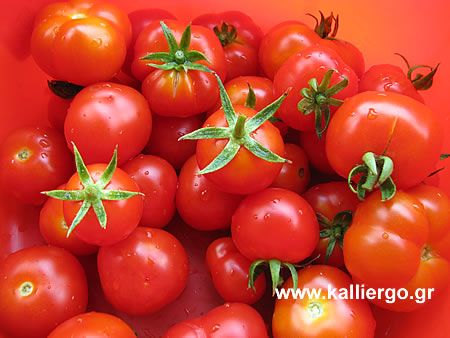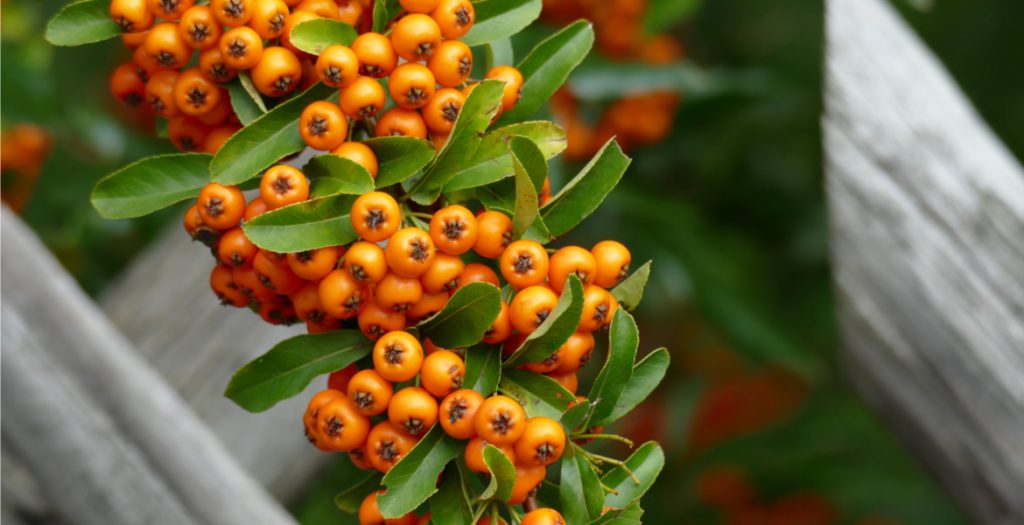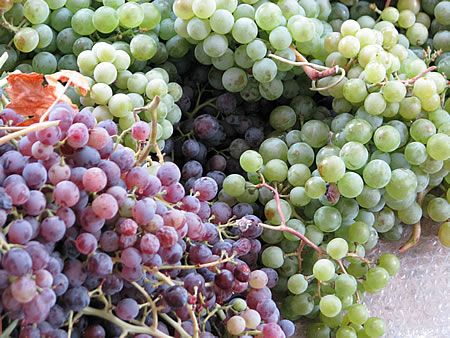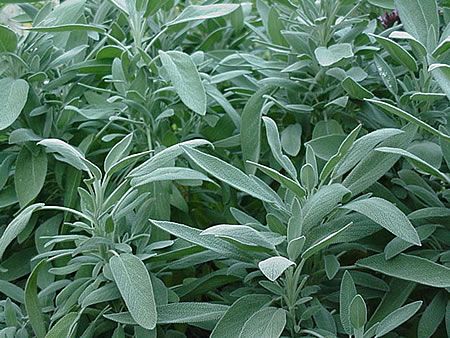Everything you need to know about growing tomatoes!
Tomatoes are one of the favorite vegetables (or fruits?) of summer. I have a hard time imagining a summer bushel that doesn’t have tomatoes in it. It’s not too late to plant your own tomatoes. Try growing tomatoes and you won’t regret it.
The aroma, the taste of home grown tomatoes can’t compare to the ones you buy. You should remember that commercial tomatoes are necessarily picked before they ripen, so they can withstand the time between harvesting and placing them on the counter or shelf.
The colour of the fruit is usually red, but there are also varieties that are orange, yellow, pink or white. The red colour is due to the carotenoid Lycopene (the main pigment in tomatoes) and the orange colour is due to beta-carotene (provitamin A). Other carotenoids and xanthophylls are also present in smaller quantities. Lycopene does not need light to form. The fruits turn red after harvesting, even in the dark. Temperatures above 32 °C prevent the synthesis of lycopene, but not of beta-carotene, which is why the fruit is not deep red but orange when temperatures are high.
Tomatoes (Lycopersicum esculentum) belong to the Solanaceae family. Peppers and aubergines belong to the same family. The tomato originates from tropical America (Peru, Ecuador) where there are many native species. In Europe, it began to be cultivated from the end of the 18th century and in Greece from 1918.
When to sow tomatoes
If you plan to start tomatoes in a seedbed, plant tomato seeds 6 to 8 weeks before the last cold weather. Practically for Greece, this means mid-February to early March. But because tomatoes love heat, make sure the place where you put the seedbed is warm. There is no point in the place where you put the seedbed being at ambient temperature. It will still be cold outside.
If you sow the tomatoes directly into the soil, the best time is late March to late April.
To get a continuous crop of tomatoes, be sure not to sow them all at once. Be sure to sow the tomatoes 2 weeks apart.
Starting tomatoes from seed
You can start your own tomatoes from seeds that you plant in a seedbed or directly in the ground.
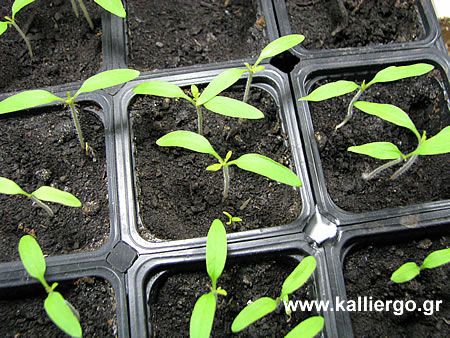
Plant the seeds at a depth of about 1 to 1.5 cm.
In both cases the soil should be enriched with nutrients, e.g. compost or digested manure. Sow 6 to 7 seeds in each location and water every 3 to 4 days.
Do not drop all the seeds in the same spot. Spread them out so that they are spaced apart from each other.
Tomato plants need light. Lots of light for them to grow.
If you put the seeds in a seed tray with artificial lighting (lamps), you need to make sure they have plenty of bright light.
If you planted the tomato seeds directly in the soil, the place should be in the sun almost all day.
The optimum of germination is observed at 20 to 25 degrees Celsius. Germination is also faster when there is a temperature difference between day and night between 4 and 5 degrees Celsius (thermoperiodism).
When the seedlings appear, you should thin them out so that there are 3 strongest or fewer in each position. Tomatoes do not like crowded conditions.
As the tomato plants grow, they will need to be wiggled around. Move? Yes, they should be hit by a draft of air for at least 10 to 15 minutes every day. The movement from the air will help them develop a strong stem.
When the plants growing in the seedbed reach a height of 8 to 10 cm and have grown 2 true leaves, they are ready for transplanting.

When transplanting tomato plants from the seedbed to the garden, be sure to bury them deeper than they were in the seedbed. Cover their stems with soil up to 1 to 2 inches below the last leaf. The tomato plant will develop roots on the part of the stem that is under the soil, and the plant will be better supported.
Starting tomatoes from seedlings
You can also plant ready-to-plant tomato seedlings in your garden that you can buy from your nearby farm supply store or nursery.
Depending on the microclimate in the area, planting the seedlings can be done in late March to early April. The ambient temperature should not be lower than 12 degrees Celsius. Below 12 degrees Celsius, the plant is damaged at all stages of its development (germination, growth, fruiting).
When transplanting, be sure to bury them deeper than they were in their pot or bag. Cover their stems with soil up to 1 to 2 cm below the last leaf. The tomato plant will develop roots on the part of the stem that is under the soil, and the plant will be better supported.
What kind of soil do tomatoes need?
Tomatoes want a soil that is warm and rich in nutrients. The tolerable soil pH for growing tomatoes is 5.5 to 7.0. The ideal soil pH is: 6.0 to 6.8.
For information on pH, see the article: Soil pH information.
John Teasdale and Aref Abdul-Baki of the U.S. Department of Agriculture’s Farm Service Agency have developed a method that utilizesHairy vetch (Vicia villosa). They first use the forage plant Vicia villosa to prepare the soil in which the tomato will be grown. They then use the same plant to create ground cover around the tomatoes.
As the wild vetch grows where the tomatoes are then sown, it enriches the soil with Nitrogen, Phosphorus and Potassium, the three essential elements that the plants need.
Wild vetch is a fodder plant (used for the production of animal feed). So, you can use it to get a better production of tomatoes and then feed your animals or make compost. With one spade, two birds.
More information can be found at:
http://www.ars.usda.gov/is/np/SustainableTomatoes2007/SustainableTomatoes2007Intro.htm
You can download the relevant form in PDF format from:
http://www.ars.usda.gov/is/np/SustainableTomatoes2007/TomatoPub.pdf
Fertilisation of tomatoes
The most important reaction of tomatoes to fertiliser application is an increase in germination. In particular, plant height, leaf area and number of flowers (and fruits) are more sensitive to the effect of nitrogen.
Nitrogen
High fruit yields can be achieved with relatively medium doses of nitrogen. (This is exactly what wild Vicus does, enriching the soil with medium doses of nitrogen).
Excessive nitrogen application leads to poor ripening, reduced and poor quality production.
The use of ammoniacal nitrogen reduces the potassium content of young seedlings and the Ca and Mg content of mature tomato leaves, probably due to competition, and increases the percentage of fruits showing symptoms of ‘blossom end rot’.
Phosphorus
The germination and fruit set of tomato plants may be reduced in soils with insufficient phosphorus supply.
Phosphorus accelerates root growth, so young seedlings should be well supplied with phosphorus at transplanting.
If the soil already has adequate amounts of phosphorus, then additional addition has no visible effect.
Potassium
Maximum tomato production can be achieved with relatively average levels of potassium. However, it is known that potassium application only to achieve maximum production results in fruit of at least average quality (colouring – taste).
The reaction of tomato plants to the addition of potassium is more pronounced in sandy and sandy loam soils and relatively less in soils with large reserves of exchangeable potassium. Plant height and yield can increase significantly in soils with low cation exchange capacity, while no reaction has been observed on leaf area, number and size of fruits (i.e. yield) in soils supplied with potassium exchange and high buffering capacity.
Increased potassium application reduces the percentage of ‘hollow’ fruits and fruits with uneven colouring, improves fruit shape and consistency and increases the total acidity of tomato juice. The sugar content and total acidity of tomato juice are two of the main parameters that determine the taste of tomatoes.
See also:
Basic knowledge about fertilizers
Tomatoes – Diseases – Symptoms of lack of nutrients in the soil
Sowing distances of tomatoes
Tomatoes are sown in parallel rows. We have two spacings. The line-to-line distance and the distance of the plants on the line.
The line-to-line distances are between 80 and 120 cm.
The distance between plants on the same line is between 30 and 90 cm. The denser the sowing distances, the more plants you can put in per unit area. At the same time, however, it needs more care, fertilization and attention.
Also, as is understandable, if you choose to grow tomato varieties with vigorous germination, then the sowing distances in the same row should be longer.
Tomato cultivation care
Pruning of tomatoes
Pruning is combined with understoring and supporting the tomato plant. Pruning makes the tomato a single-stemmed plant.
All lateral shoots are removed when they reach a length of 5 to 10 cm. Young lateral shoots are removed by hand, as they are tender and fragile. Removing the shoots while they are still small avoids large wounds that are difficult to heal and increase the risk of pathogens and fungal infections being transmitted through the wounds.
Pruning must be repeated every week to remove the lateral shoots that the plant is constantly producing, while the stem of the plant must be undercut.
Tomatoes that are pruned can be planted at close distances.
Tomato corms
If you want to speed up tomato production, you can proceed to top-dressing (removing the top of the plant) 1.5 to 2 months before the end of the harvest. Topping is applied to stop the plant from producing new leaves and inflorescences that will not have time to ripen, and also to force the plant to accelerate the ripening of the fruit it already has. The top is removed after at least 2-3 leaves from the last inflorescence of the plant.
Defoliation of tomato plants
As the plants grow and when the first inflorescence begins to mature, the process of defoliation, i.e. the removal of the leaves underneath, begins. The peeling is done to allow better lighting of the fruit close to the ripening stage, as direct light improves the quality of the fruit.
The leaves at this stage are removed because, as they are beginning or already ‘old’, they do not receive enough light for photosynthesis and do not contribute to production.
Defoliation continues after harvesting the fruit of the lower inflorescence and when the next inflorescence begins to ripen, for the reasons mentioned above.
Tomato understaying-supporting
The tomato is a vigorously growing plant. You have two options for root stocking.
Option A
Support the plant.
You will find several support variations.
The simplest way of supporting it is using a pole. The pole can be wooden or plastic. Avoid using metal poles (unless they are covered with a neutral material), because they get very hot from the sun and the plant wants to avoid them.
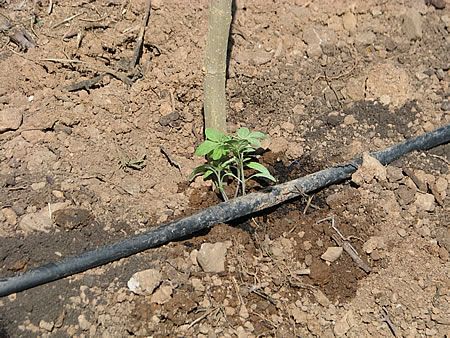
Drive the pole into the ground before sowing seeds or transplanting plants. This way you won’t hurt the plant’s root system when placing the pole.
As the plant grows you should cut off the side shoots that are growing to encourage upward growth. Tie the stem of the plant to the pole from time to time.
Another way of supporting it is by using a cage. Place a cylinder of mesh fencing with large eyes around where the tomato plant is growing. The tomato shoots are passed through the mesh openings and supported. However, this method of support also presents problems.
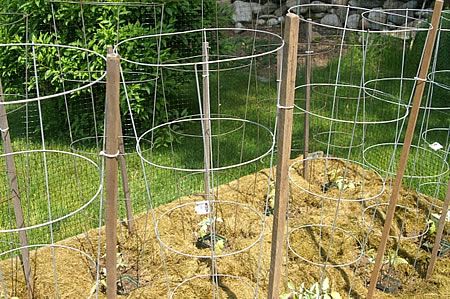

You may not be able to harvest the tomatoes growing in the cage. You cannot access the parts of the plant that are inside the cage. The parts of the plant growing inside the cage are prone to fungal infections due to poor ventilation and lack of light. You can’t dig up the soil around the plant because it is blocking the cage.
Instead of poles you can grow a system of horizontal wires and vertical twine. The horizontal wires are placed at a height of 1.80 to 2.00 metres above the planting line of the tomato plants. From the wire and above each plant, vertical twine is attached to the soil.
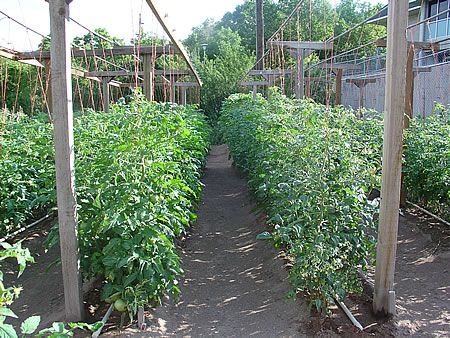
The end of the string that ends in the soil:
- is attached to a stake placed next to the plant.
- tied to the bottom of the trunk of the plant in such a way that it does not tighten the trunk.
Tomatoes are grown and fixed around the twine. It is understood that at the edges and in between the system, there will be posts supporting the whole system.
For additional information see: Staking and Training Tomatoes
Option B
Do nothing and let the plant grow freely. Sooner or later it will buckle under the weight and number of tomatoes. But it will continue to grow. This no-support mode makes the plant susceptible to fungal attack as its leaves are close to the soil, out of the sun and not ventilated.
Fertilization and fruiting of tomatoes
The tomato is a self-pollinating plant. In order for the fruit to set, the flower must first be pollinated. The flower produces pollen grains, which germinate and fertilise the oocytes in the ovary. The germination stage of the pollen grains lasts 48-55 hours and is influenced by temperature, light, the physical condition of the stigma and the variety.
The optimum temperatures for pollen germination range between 21-29 degrees Celsius. Temperatures higher or lower adversely affect flower pollination. At high temperatures, the flower head becomes excessively elongated, the anthers are deformed and the germination of the pollen grains is slowed down.
When the temperature exceeds 32 degrees Celsius, even for a short period of time, fruit set decreases sharply. At low temperatures, below 13 degrees Celsius, pollen life and fertility are reduced by up to 20 %, the anthers are deformed and the number of flowers in the florets is reduced.
In addition to temperature, flower pollination, as mentioned above, is affected by the relative humidity of the air (optimal 60-70%). In high relative humidity or excessively dry atmospheres, pollen is released with difficulty or not at all. Under conditions of high atmospheric humidity, pollen forms moist aggregates that are not easily deposited on the vine and ultimately, we do not get satisfactory fruiting.
Tomato irrigation watering
It is of particular importance for a good tomato production to water regularly and not to give the necessary amount of water in bulk. Watering is usually done by drip irrigation.
Water the tomatoes frequently and consistently. You should water enough so that the water reaches the roots and does not just stay on the surface. Irregular or little watering stresses the tomato plant and causes diseases such as dry or black top of fruit (blossom end rot) or bursting of the tomato fruit.
Co-growing tomatoes
Along with tomatoes, you can sow the following plants:
- Basil
- Oregano
- Parsley
- Carrots
- Marigold
- Celery
- Onions
Avoid growing tomatoes with…
Avoid intercropping tomatoes with:
- Potatoes
- Beetroot
- Cabbage
- Peas
- Corn
- Rosemary
- Dill
How to preserve tomato seeds
You can collect your own seeds from the tomatoes growing in your garden and save them for next year.
Read the following article: Making tomato seeds
How to make tomato seeds
There are a large number of tomato varieties and hybrids.
They are divided into two major categories: Industrial and those for fresh consumption.
Industrial tomato varieties
These varieties are generally ‘dwarf’ and small-fruited. The time from transplanting to the ripening of about 50 % of the fruit is 90-110 days.
Some of the industrial tomato varieties currently grown in Greece are: sonora, oval red, red ball, titano, rio grande, tomato of Santorini.
Tomato varieties for fresh consumption
They are local varieties or hybrids. They are climbing plants with medium to large vegetative growth, medium to large fleshy or large fleshy.
Tomato diseases
See the relevant article: Tomatoes – Diseases – Symptoms of lack of nutrients in the soil.
Tips for growing tomatoes – Symptoms of diseases – Disease symptoms – Tomato deficiencies
If you start your tomatoes from seed, drop 6 to 7 seeds in each seedbed position, but keep only the 3 strongest plants. Tomatoes don’t like crowded conditions. The same is true if you sow your tomato seeds directly into the soil.
Tomatoes like a lot of sun. Choose to plant them in the brightest and sunniest part of the garden. Even when they are still in the seedbed, they should have plenty of light, even if it is artificial (with lamps).
In order to develop a strong stem (trunk or stem), tomato plants should be moved early. Even when they are in the seedbed they should dance in the air. While they are in the seedbed, be sure to create a light breeze for 10 to 15 minutes each day. The movement will help them harden their stems.
The warmer the weather in April and May, the faster you will have tomatoes. Tomatoes love the heat.
When transplanting tomatoes from the seedbed to the garden, be sure to bury them deeper than they were in the seedbed. Cover their stems with soil up to 1 to 2 cm below the last leaf. The tomato plant will develop roots on the part of the stem that is under the soil, and the plant will be better supported.
After the soil is warm enough from the sun (late April to mid-May), spread a layer of dry leaves or black compost around the tomato plants. Both will further warm the soil while preventing moisture from evaporating.
Remember to remove the bottom leaves regularly. Because these leaves get the least amount of sunlight, they are the first leaves to be affected by fungus. You will see for yourself that the lower leaves on tomatoes turn yellow easily and generally present a not-so-healthy appearance. Cut them off and you will do your tomatoes good.
As the plant grows, you can remove the young shoots that appear at the branching points of the stems. These shoots will not produce fruit, only leaves. Do not overdo it, however. It is in the leaves that photosynthesis takes place, producing the sugars that will give the plant strength and flavour to the tomatoes.
Water the tomatoes frequently and consistently. You should water enough so that the water reaches the roots and does not just stay on the surface. Irregular or little watering stresses the tomato plant and causes diseases such as dry or black top of fruit (blossom end rot) or bursting of the tomato fruit.
Do not plant all tomato plants at the same time. If you want to have fresh tomatoes all summer long, plant them 15 days apart. For example, if you plan to plant 15 tomato plants, plant 5 the first week, 5 after 2 weeks, and 5 more after another 2 weeks.

Sources
http://gardening.about.com/od/growingtips/tp/Tomato_Tips.htm
http://www.ars.usda.gov/is/np/SustainableTomatoes2007/SustainableTomatoes2007Intro.htm
http://www.ars.usda.gov/is/np/SustainableTomatoes2007/TomatoPub.pdf
http://www.tomatogardeningguru.com/
http://en.wikipedia.org/wiki/List_of_companion_plants
http://msucares.com/lawn/garden/vegetables/tomatoes/index.html
Tags: CULTIVATE • CULTIVATION • PLANTS SUPPORT • TOMATO • TOMATOES

